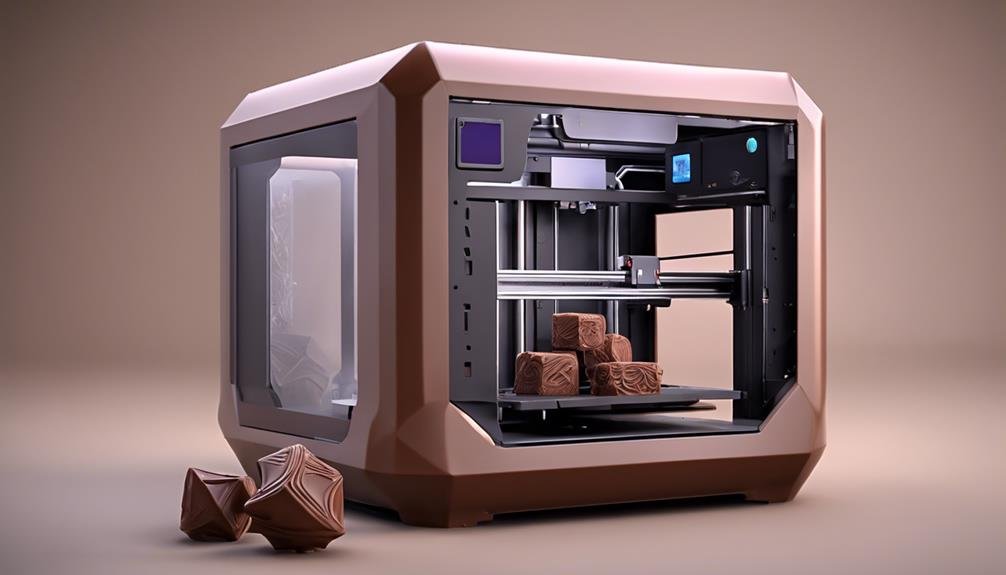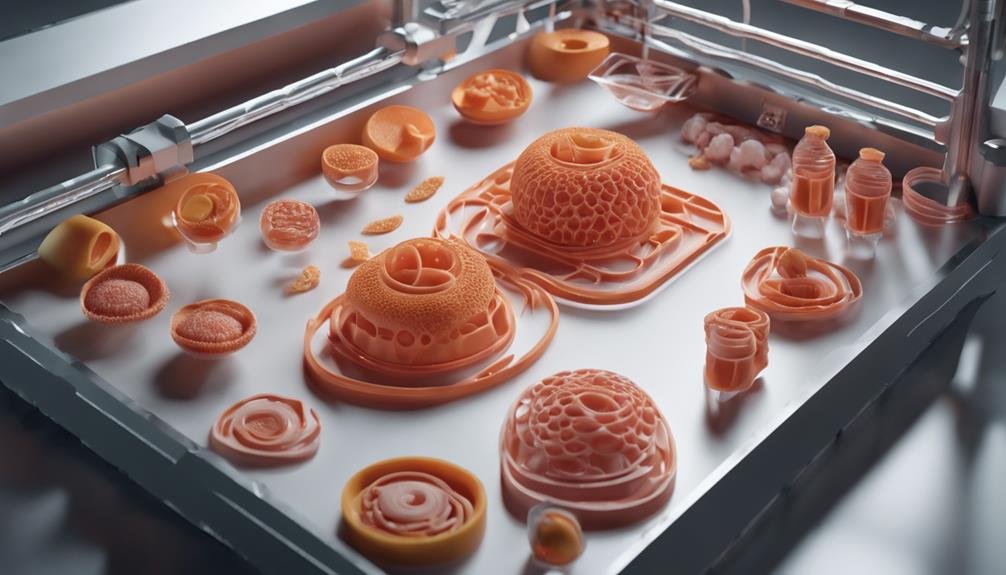Step into the domain of 3D food printing, where you can craft personalized meals for diverse dietary needs and enhance flavor profiles while minimizing food waste. This technology reshapes culinary arts with intricate designs, streamlining production processes and reducing costs considerably. Venture into a world where you can customize shapes, textures, and flavors, revolutionizing food preparation and presentation while improving production efficiency. Investigate the materials such as purees, doughs, cultured meats, and innovative techniques like Fused Deposition Modeling. Uncover the challenges in regulatory approvals, equipment costs, and achieving intricate taste profiles. Explore the vast future potential and sustainability benefits awaiting in this cutting-edge field.
Benefits of 3D Food Printing
Learn about the numerous benefits that 3D food printing brings to the table in the food industry.
3D food printing offers a range of advantages, including the ability to create customizable meals that cater to specific dietary needs. This cutting-edge technology boosts nutrition and flavor profiles by allowing precise control over ingredients and portion sizes. Furthermore, 3D food printing contributes to sustainability by reducing food waste through the utilization of alternative ingredients like plant-based materials.
The intricate designs and creative food possibilities achievable through 3D food printing are revolutionizing culinary arts and presentation, offering a new level of creativity in the food industry. Additionally, the cost-cutting benefits of this technology are substantial, as it enables efficient ingredient use and streamlined production processes.
Embracing 3D food printing can lead to personalized nutrition and innovative designs, making it a game-changer in the modern food industry.
Applications in Food Industry
3D printing technology in the food industry enables customization of shapes, textures, and flavors in food production, offering a new dimension to culinary creativity. Applications of 3D printing in the food industry are vast and diverse. From creating intricate designs for pastries to offering personalized nutrition options, the technology is revolutionizing the way food is prepared and presented.
Food companies are increasingly turning to 3D printing to reduce waste, improve efficiency, and cater to evolving consumer preferences for unique dining experiences. This progressive approach isn't limited to conventional kitchens but extends to commercial settings, restaurants, and even space missions, where sustainable food production is vital.
Chefs and food technologists are embracing 3D food printing as a tool for pushing the boundaries of culinary creations, exploring new textures, shapes, and flavors that were previously unimaginable. As this technology continues to evolve, it promises a future of limitless possibilities for the food industry.
Materials and Techniques Used

Different materials and techniques are utilized in 3D food printing to create a wide range of edible items with unique textures and structures. Ingredients such as purees, doughs, pastes, cultured meats, chocolate, and cheese are commonly used in the process.
Different techniques like Fused Deposition Modeling (FDM), Selective Laser Sintering (SLS), and Binder Jetting are employed to layer these food materials during additive manufacturing. These materials can be extruded through a nozzle to form intricate shapes and designs.
Soft materials, powdered ingredients, and low viscosity substances play a crucial role in achieving the desired textures and structures in 3D printed food items. The use of multi-printhead and multi-material printing capabilities allows for the creation of complex and customized food options in the industry.
Moreover, post-processing methods such as baking, cleaning, and the incorporation of additives are necessary to improve the structural integrity and quality of the final printed food products.
Challenges in 3D Food Printing
Regulatory approvals present a significant challenge in the 3D food printing industry, requiring compliance with stringent food safety standards and regulations.
The cost of equipment remains a hurdle, impeding the widespread adoption of 3D food printing in commercial settings.
Scalability issues persist due to the current limitations in production speed and scale, hindering large-scale implementation.
Achieving intricate taste profiles and textures poses a challenge in 3D food printing, demanding further research and development to improve flavor complexity.
Additionally, specialized training is essential for operators to navigate the intricacies of 3D food printing successfully.
Flavor complexity and texture challenges further compound the compliance challenges faced by the industry.
Overcoming these obstacles necessitates creative solutions and collaborative efforts to advance the capabilities of 3D food printing technology.
Addressing these challenges will pave the way for a more robust and efficient 3D food printing ecosystem in the future.
Future Potential of Food Printing

Exploring the future potential of food printing involves delving into creative applications beyond current challenges, opening doors to personalized nutrition and sustainable food solutions. As advancements continue in the field of 3D food printing, the following aspects are key to shaping the future landscape:
- Healthier Food Options: The future of food printing holds the promise of not only desserts but also nutrient-rich meals tailored to individual dietary requirements.
- Space Missions: Innovations in 3D food printing are essential for providing astronauts with nutritious and safe food options during extended space missions.
- Sustainable Food Production: Collaboration between organizations like NASA and startups is paving the way for sustainable and efficient food production methods, including plant-based alternatives and hybrid meat production.
These developments indicate a shift towards a future where food printing can cater to personalized nutrition needs, offer healthier choices, and contribute to sustainable food practices, whether on Earth or in the vast expanse of space.
Examples of Printed Food
Showcasing the creative applications of 3D printing technology in the food industry, a variety of examples of printed food demonstrate the diverse range of possibilities for culinary creativity and sustainability. By utilizing food printers, imaginative chefs and food scientists can create unique dishes like hybrid meats, vegan salmon filets, seafood alternatives, and even printed pasta. These culinary explorations go beyond traditional boundaries, offering plant-based alternatives that mimic the taste and texture of meat while providing sustainable options for environmentally conscious consumers.
| Printed Food | Description | Benefits |
|---|---|---|
| Vegan Salmon Filets | Plant-based alternatives that replicate the taste and texture of salmon, providing a sustainable seafood option | Environmentally friendly, cruelty-free |
| Seafood Alternatives | Diverse range of 3D printed seafood options for those seeking sustainable and imaginative culinary experiences | Reduced environmental impact, creative menu possibilities |
| Mashed Potatoes | 3D printed mashed potatoes offering unique shapes and designs for visually appealing dishes | Customizable, adds a creative touch to traditional recipes |
| Hybrid Meats | Imaginative creations using bio ink scaffolded from stem cells to mimic traditional meat structures | Sustainable, showcases the potential of 3D printed foods |
| Printed Pasta | Customized pasta shapes made from durum wheat semolina and natural extracts for culinary exploration | Creative designs, personalized pasta options for chefs |
Safety Considerations in Food Printing

Maintaining a clean environment during the food printing process is vital for preventing bacterial accumulation and ensuring food safety. Adherence to food-handling standards and hygiene practices is key to guarantee microbial stability and material safety in 3D food printing.
Moreover, regulatory hurdles in food printing technology encompass concerns about copyright issues associated with replicating existing food products and meeting food safety standards. Proper sanitation of equipment and the utilization of fresh ingredients are pivotal safety practices to adhere to during 3D food printing processes.
Ensuring equipment sanitation plays a significant role in preventing contamination and upholding food safety standards. Fresh ingredients not only contribute to the quality and taste of the printed food but also reduce the risk of bacterial growth. Regulatory bodies often emphasize the importance of following stringent hygiene practices to mitigate health risks and ensure consumer safety.
Embracing these safety considerations is paramount in the successful integration of 3D food printing within the food industry.
Impact on Sustainability and Waste Reduction
Utilizing 3D printing technology in the food industry makes a substantial contribution to sustainability efforts and waste reduction through creative ingredient choices and novel culinary approaches. By printing food items with alternative ingredients like plant-based materials and sustainable protein sources such as insects, the industry can greatly reduce food waste.
Collaboration between 3D printing and culinary arts enables the exploration of new food textures, flavors, and structures, fostering sustainable practices in food production.
Moreover, the use of food waste for 3D printing not only minimizes waste during consumption but also drives inventive solutions for sustainable food creation. Incorporating sustainable protein sources into printed food items plays a vital role in decreasing the environmental impact associated with traditional food production methods.
The potential annual reduction of food waste through the implementation of 3D printing technologies highlights the positive environmental impact and sustainability benefits of this innovative approach in the food industry.
Frequently Asked Questions
How Is 3D Printing Used in the Food Industry?
In the food industry, 3D printing revolutionizes culinary innovation by improving customized dishes, intricate food designs, and gourmet creations. It elevates food presentation, edible creations, flavor combinations, and sustainable practices. This culinary technology merges art with design.
Is It Safe to Eat 3d-Printed Food?
Eating 3D-printed food is safe when made with clean equipment and fresh ingredients according to food-handling standards. Proper hygiene is key for safety. Just like regular food, handle it correctly.
Is There a 3D Printer That Prints Food?
Yes, there is a 3D printer that prints food. You can enjoy flavor customization, culinary creativity, edible designs, ingredient compatibility, texture control, sustainable production, a culinary revolution, food presentation, culinary artistry, and culinary innovation with this technology.
What Is the Difference Between 3D and 4D Food Printing?
In 3D vs 4D printing, 4D goes beyond static shapes with dynamic changes. Taste, efficiency, customization, and speed improve. Ingredient compatibility, health, and environmental considerations are essential. Culinary creativity thrives with market demand.
Conclusion
To sum up, 3D food printing offers numerous benefits and potential applications in the food industry. While there are challenges to overcome, such as material selection and safety considerations, the future of food printing looks promising. 3D food printing has the potential to revolutionize the way we consume and produce food, offering customized nutrition, unique textures, and innovative designs. With the advancements in futuristic manufacturing technology, such as 3D printing, the food industry can look forward to increased efficiency, reduced waste, and a whole new world of culinary possibilities. As research and development in 3D food printing continue to progress, we can expect to see even more groundbreaking applications emerge in the years to come.
By utilizing advanced techniques and materials, we can revolutionize the way food is prepared and consumed, leading to increased sustainability and reduced waste.
The possibilities are endless, making 3D food printing an exciting and pioneering field to watch.
Contents
- 1 Benefits of 3D Food Printing
- 2 Applications in Food Industry
- 3 Materials and Techniques Used
- 4 Challenges in 3D Food Printing
- 5 Future Potential of Food Printing
- 6 Examples of Printed Food
- 7 Safety Considerations in Food Printing
- 8 Impact on Sustainability and Waste Reduction
- 9 Frequently Asked Questions
- 10 Conclusion